Written by Dustin Kohn, SDSU Agronomy, Horticulture, and Plant Sciences Department undergraduate student, under the direction and review of Kristine Lang, Assistant Professor, and Rhoda Burrows, former Professor & SDSU Extension Horticulture Specialist. Special thanks to Zoey Stefanich and Anne Bartz for peer review of this article.
Introduction to Leeks
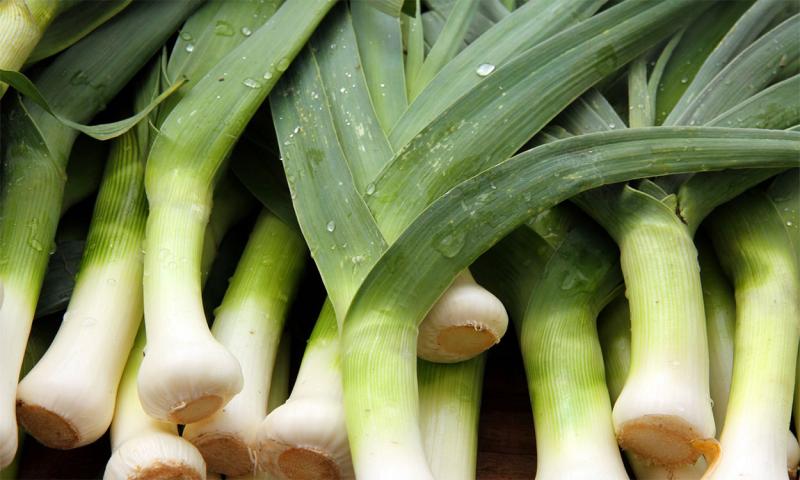
Leeks (Allium ampeloprasum var. porrum) are a crop very similar to onions. Leeks have a mild flavor and can be served raw or cooked. The part of the leek that is commonly consumed is the white, lower stem. The green portions are edible but not normally consumed because of their toughness. Leeks offer a wide variety of antioxidant properties that are known to help with improving liver and gastro-intestinal tract functions and decreasing blood pressure.
Leeks are a true perennial, even though they are often referred to as a biennial. Leeks are a cool-season crop that can be grown in the Midwest. Because most varieties require 80 to 120 days to reach maturity, they are usually grown from transplants.
Below are a few of the more-common varieties of leeks.
Types of Leeks
Early-Season
- Varna (50 days) is a tall “bunching” type developed for thick direct seeding to produce clumps of slender plants.
- King Richard (75 days) is a summer leek with long, slender, sweet, and white stalks. It has some frost resistance (to 20 degrees Fahrenheit) but will not overwinter.
Mid-Season
- Dawn Giant (98 days) grows up to 15 inches long and two inches in diameter.
- Jolant (100 days) is a medium-sized leek that is moderately winter hardy.
- Lancelot (105 days) is a short leek with a large, cylindrical stalk; moderately winter hardy.
- Splendid (105 days) is a rapid and vigorous grower that is winter tender. Seven to eight inches long. Medium-green and non-bulbous.
- Albinstar Baby Leek (110 days) is a Dutch variety developed for the baby leek market. It is ready to harvest at ½ inch diameter but can be left in the ground to grow larger.
Late-Season
- Otina (120 days) is a French variety bred for mild and delicate flavor. Very vigorous and rapid growing.
- Titan (120 days) is an older but reliable variety. White stalks reach eight inches and form bulbs at the base.
Overwintering
Try these varieties for possible overwintering (with generous mulching):
- Bandit (125 days) thick stalks with upright foliage.
- Autumn Giant (110 days) heirloom variety has survived -10 degrees Fahrenheit in some trials.
- Tadorna (105 days) medium length stalk, has survived -10 degrees Fahrenheit in some trials.
Managing Leek Quality
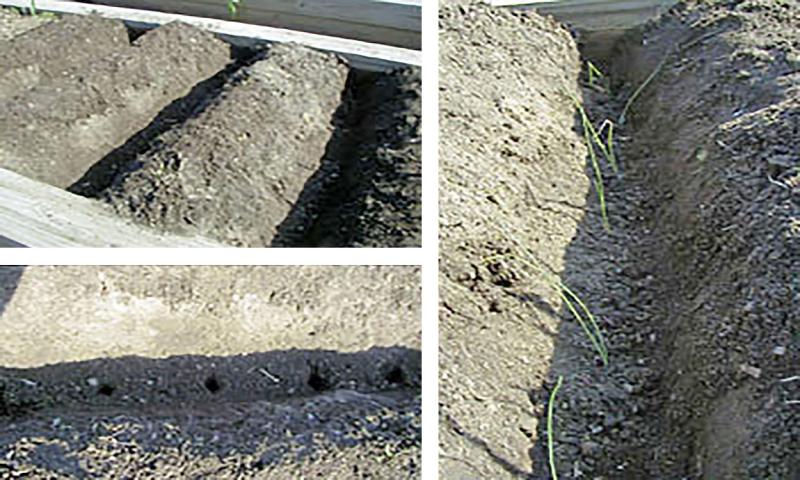
The key to having a successful leek crop starts at planting. To grow a large, white section of the leek, the stem must be blanched. You can blanch leeks by hilling the soil up around the stalk as it develops, or by planting seedlings into a trench six to eight inches deep and then gradually filling the trench as the plant grows, as in growing asparagus. Space leeks six to nine inches apart.
During the middle of summer, remove the top half of the leaves to encourage greater stalk growth. Additional nitrogen fertilizer may be side dressed at that time to help boost leek growth.
Leeks are affected by many of the same pests and diseases that affect onions, including the ones listed below.
Pests and Diseases
Onion Thrip
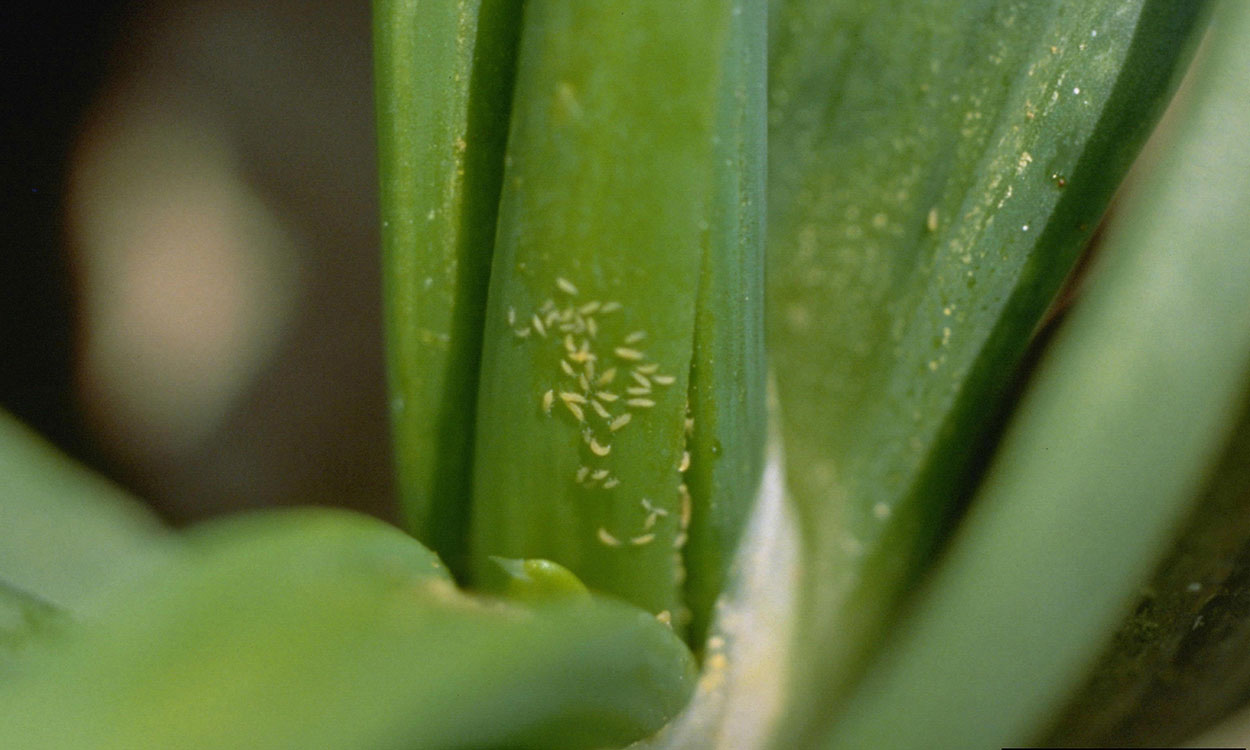
One common pest in leeks is the onion thrip (Thrips tabaci), which can cause problems under hot, dry conditions. You will observe tiny, silvery-white spots on the leaf surface, and, in severe infestations, the leaves may dry out.
Onion Maggot
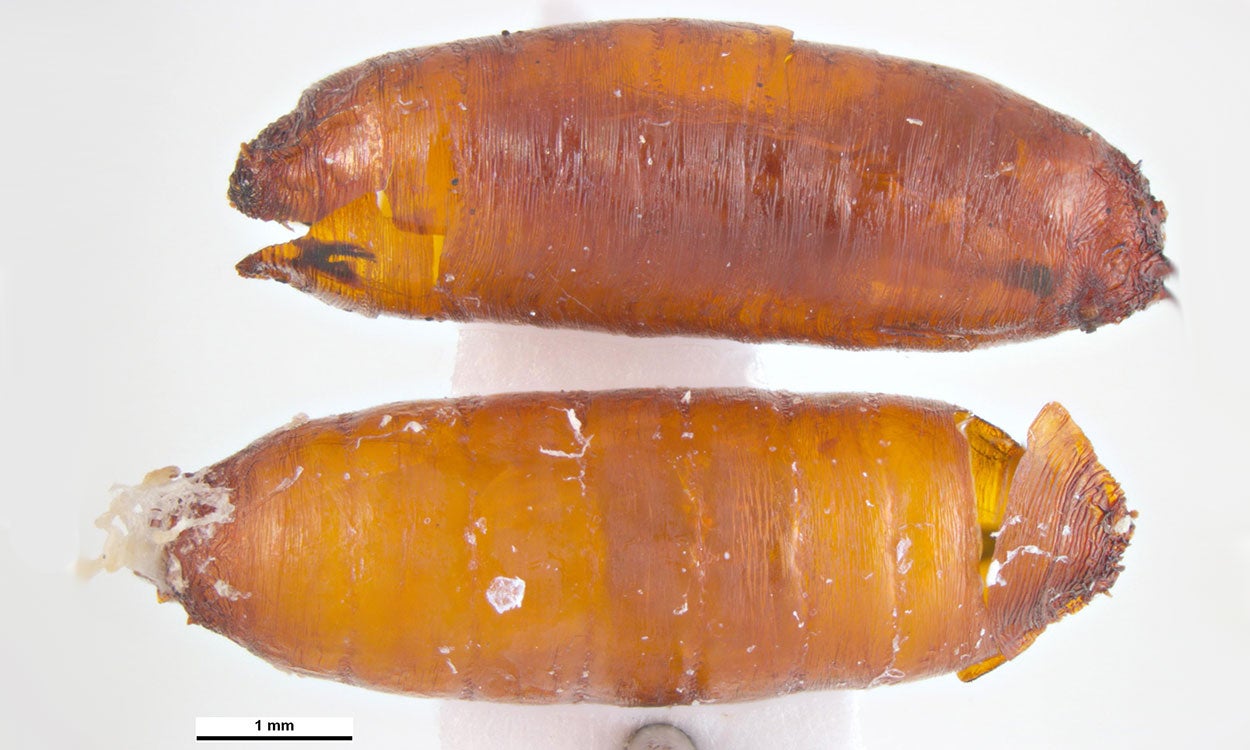
Another common pest is the onion maggot (Delia antiqua). Onion maggots can occasionally feed on the plant’s roots, causing wilting and reduced growth.
Diseases
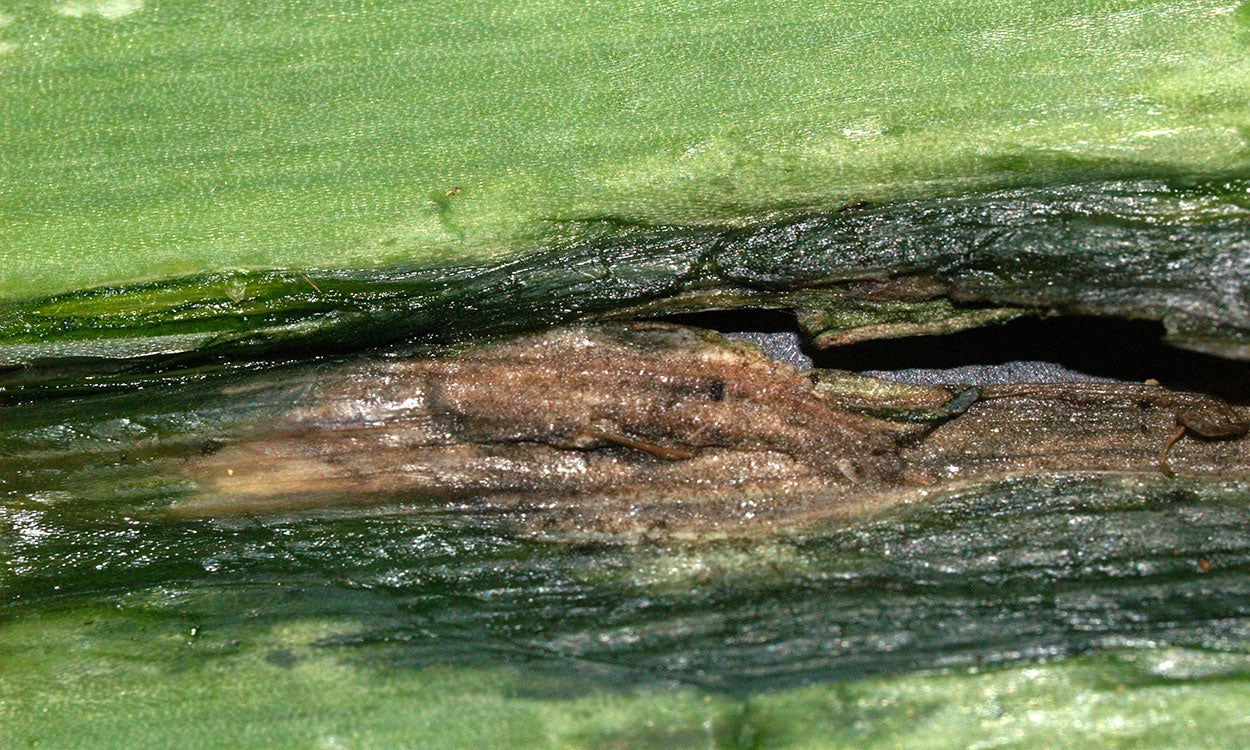
Diseases are less common, but white rot, rust, pink root, purple blotch, downy mildew, botrytis leaf spot, botrytis neck rot and smudge can occur.
When to Harvest Leeks
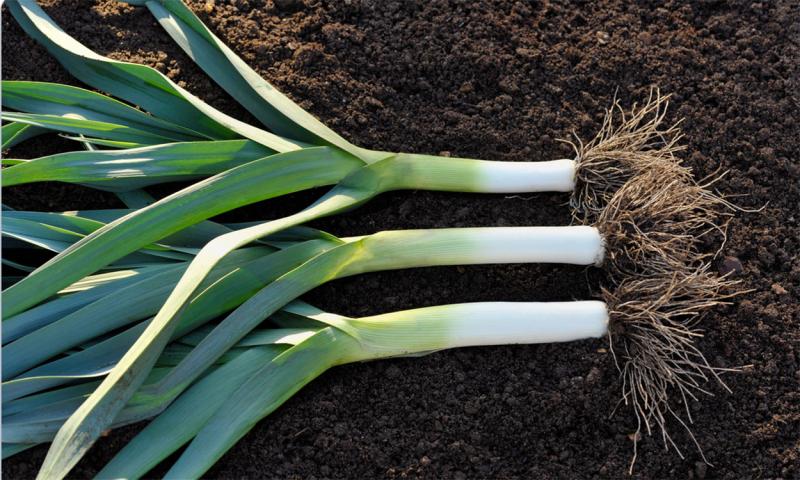
Compared to onions, leek tops do not brown and die back. The standard gauge of when to harvest leeks is when the stem width is bigger than one inch. Some smaller varieties mature at one-half to three-fourths of an inch in diameter. A quality leek should have a firm, white stem that is more than three inches long. What you don’t want to see is swelling at the base at the leeks. This is called "bulbing," and is undesirable. Harvest can be delayed until after the first few frosts. If temperatures start to go below 20 degrees Fahrenheit, mulch the mounds of leeks to protect them.
How to Harvest Leeks
Commercially harvested leeks are manually pulled from the field by workers. This is a very labor-intensive process accomplished by large, manned rigs, also known as mobile packing vehicles. In the rig, crops can be picked, trimmed, washed, and packed right in the field.
In home gardens, leeks are a very easy crop to harvest due to their shallow roots that allow for ease of pulling. Compared to crops, such as onions that are generally harvested all once, you can harvest leeks as you need them from the garden. At harvest, gently twist the leek and pull them from the garden. They can also be dug, but be careful not to damage the bulb of the leek, as it will shorten its storage life. The leaves can be trimmed to make them a more-manageable length for harvest.
Cleaning Leeks
Commercially, the first cleaning of leeks happens in the field. At harvest, the green leaves and the bottom of the leeks are cut off right in the field, reducing the amount of dirt on the leeks before the cleaning process. Once harvested, they are carried into the rig on a conveyor belt, where they go through a wash cycle. Once they are washed and rinsed, they are packaged in the rig for the end consumers. When purchased by the consumer, one final cleaning is recommended. There is often a small amount of soil held tightly between the leaves from harvest. Consumers can remove the remaining top portion of the green leaves to help with cleaning. When ready to cook them, slice the whole leek lengthwise, separate the layers, and rinse thoroughly to remove any remaining soil.
Sorting and Marketability of Leeks
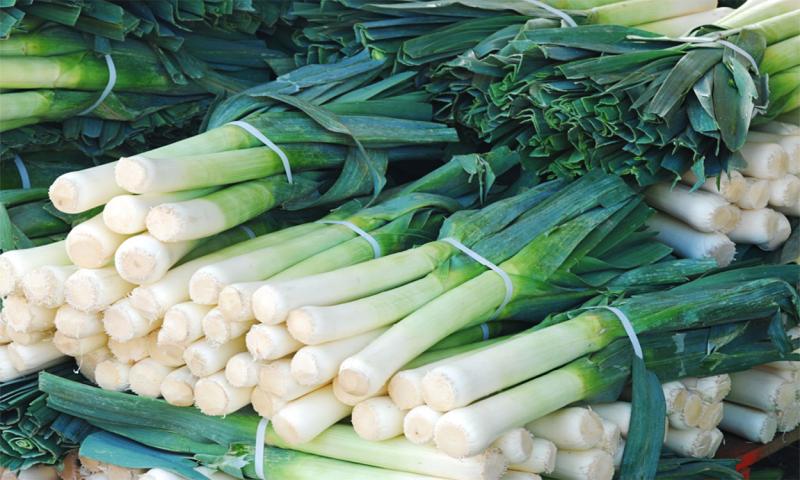
The USDA does not have standards for leeks. According to the European standards, leeks are sorted into two classes:
Class 1
- Leeks in this class must be of good quality.
- They must be characteristic of the variety and/or commercial type.
- The white to greenish-white part of the leeks must represent at least one-third of the total length of the sheathed part.
- The following slight defects may be allowed, provided these do not affect the general appearance of the produce, quality, and presentation:
- Slight superficial and dry damage on no more than two leaves.
- Slight bruising on the leaves.
- Slight damage caused by thrips on the leaves.
Class 2
- This class includes leeks that do not qualify for Class 1, but satisfy the minimum requirements specified above.
- The following defects may be allowed, provided the leeks retain their essential characteristics as regards to the quality, the keeping quality and presentation:
- Slight superficial and dry damage.
- Slight bruising.
- Damage caused by thrips.
- Slight traces of rust on the leaves.
- Slight brownish discoloration due to low temperatures.
- A tender flowering stem if it is enclosed within the sheathed part.
Harvest and Post-harvest Food Safety
The primary food safety concerns with leeks are that they are in contact with soil, which can transfer pathogens onto the leeks. They also have crevices, where soil or debris can hide; when harvesting it is important to knock off as much loose soil as feasible and then thoroughly rinse the leeks. Along with cleaning, cooking leeks helps to eliminate any contamination from the soil.
On-farm Storage of Leeks
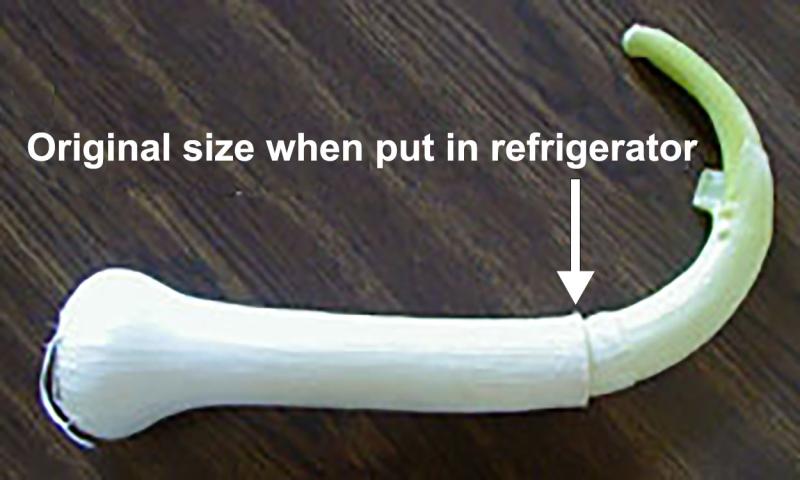
Leeks may be left in the garden and dug as necessary until late fall. To keep the leeks protected from the cold, hill them up with soil around the plants and cover them with a heavy layer of mulch when temperatures start to go below 20 degrees Fahrenheit.
Leeks can be stored commercially for 2 to 3 months at 32 degrees Fahrenheit with high humidity to prevent wilting. When harvesting from the garden, leeks can be stored for 7 to 10 days in a refrigerator with the optimum flavor. Leeks will keep in your refrigerator for at least a month, but the quality will diminish over time. When the plant is harvested and stored in the fridge, it will slowly continue to grow for months. Some South Dakota gardeners store leeks in damp wood shavings or sand, or in a root cellar or cool location for months during the fall and winter.
Marketing Leeks
Leeks can be marketed directly both to consumers and restaurants. Perhaps the most-common and popular dish made from leeks is potato leek soup. Leeks are sometimes marketed for their health benefits. Leeks possess a wide variety of antioxidant properties and are known to improve liver and gastro-intestinal tract functions, along with decreasing blood pressure. These qualities are what make leeks great health vegetables. Leeks are easy to incorporate into recipes because of their similar but milder flavor profile to onions.
References
- Drost, Dan. Leeks in the Garden, Utah State University Extension, Mar. 2020, Retrieved November 10, 2022.
- Golubkina, Nadezhda A., Timofey M. Seredin, Marina S. Antoshkina, Olga V. Kosheleva, Gabriel C. Teliban, and Gianluca Caruso. 2018. Yield, Quality, Antioxidants and Elemental Composition of New Leek Cultivars under Organic or Conventional Systems in a Greenhouse, Horticulture 4, no. 4: 39. Retrieved November 20, 2022.
- Growing Fresh Market Onions, Garlic, and Leeks, University of Wisconsin-Extension, Retrieved November 18, 2022.
- Growing Leeks in a Home Garden. University of Maryland Extension, 8 Aug. 2022, Retrieved November 20, 2022.
- MacKenzie, Jill, and Authors: Marissa Schuh. Growing Leeks in Home Gardens. UMN Retrieved November 18, 2022, Extension, 2022.
- Mahr, Susan. Leeks. Wisconsin Horticulture, University of Wisconsin – Madison, Retrieved November 15, 2022.
- UNECE Standard FFV-21. UNITED NATIONS New York and Geneva, 2017, Retrieved November 22, 2022.


